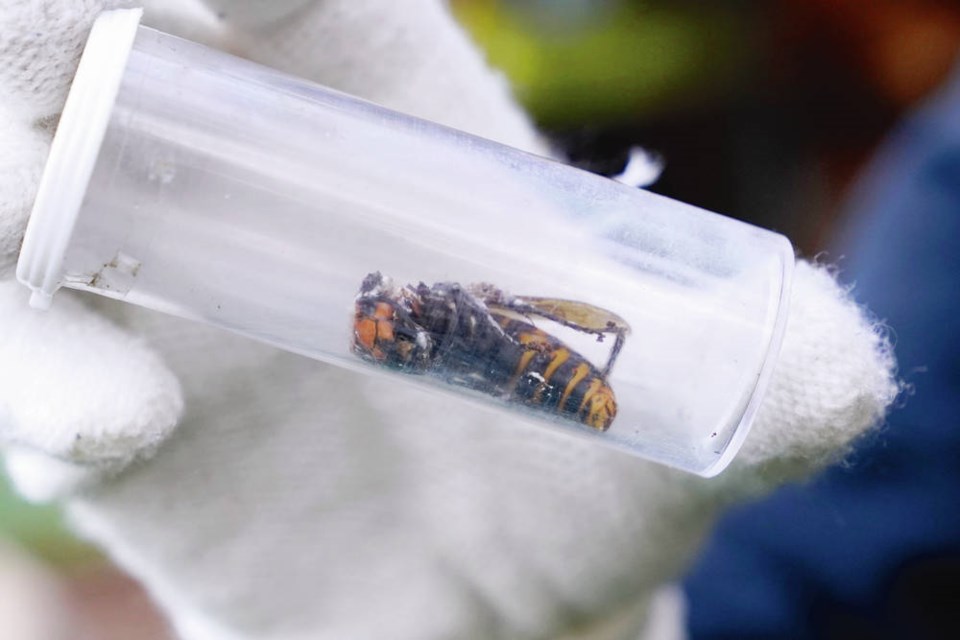B.C.’s top apiculturist is hoping to declare Vancouver Island free of the Asian giant hornet in September, pending no new sightings of the so-called “murder hornets” over the summer.
There hasn’t been a confirmed sighting of the unusually large hornet on the Island since September 2019, said Paul van Westendorp, provincial apiculturist with the Ministry of Agriculture. If two full seasons pass without a report of an invasive species, the area is generally considered safe from the pest, he said.
The province is focusing its attention this summer on the Fraser Valley, where five Asian giant hornets were found by the public in 2020, van Westendorp said. They’re setting up traps — bottles filled with a sweet liquid that attracts the insect — along the U.S. border from White Rock to Aldergrove.
On the Island, they’ll rely on beekeepers and the public to report sightings of any unusually large hornets to www.bcinvasives.ca.
Van Westendorp said the epicentre for the invasive species appears to be in Washington state, where scientists recently confirmed a dead Asian giant hornet north of Seattle, the first one discovered in the U.S. or Canada this year.
Entomologists from the state and U.S. Agriculture departments said it’s the first confirmed report from Snohomish County and appears to be unrelated to the 2019 and 2020 findings of the hornets in Canada and Whatcom County, along the Canadian border, that gained widespread attention.
The five-centimetre-long invasive insects, first found near the U.S.-Canadian border in December 2019, are native to Asia and pose a threat to honeybees and native hornet species. While they’re not particularly aggressive toward humans, their sting is extremely painful and repeated stings, though rare, can kill.
The world’s largest hornet is much more of a threat to honeybees that are relied on to pollinate crops. They attack hives, destroying them in mere hours and decapitating bees in what scientists call their “slaughter phase.” How they got here from Asia is unclear, although it is suspected they travel on cargo ships.
“Hitchhikers are a side effect of all the commerce we do globally,” said Sven Spichiger, an entomologist with the Washington state Agriculture Department who is leading the fight to eradicate the hornets.
In the latest sighting, a resident found the dead hornet on his lawn near the city of Marysville and reported it June 4 to the state agency. Entomologists retrieved it June 8, reporting that it was very dried out and a male hornet.
Given the time of year, the fact that it was a male and that the specimen was exceptionally dry, entomologists believe it was an old hornet from a previous season that wasn’t discovered until now, officials said. New males usually don’t emerge until at least July.
There is no obvious pathway for how the hornet got to Marysville, officials said.
“The find is perplexing because it is too early for a male to emerge,” said Dr. Osama El-Lissy, deputy administrator for the U.S. Department of Agriculture’s quarantine program.
El-Lissy said the federal agency would work with state officials “to survey the area to verify whether a population exists in Snohomish County.”
Because it was found for the first time in that county and had different colouring than previously collected specimens in North America, the hornet was submitted to the federal Animal and Plant Health Inspection Service for final verification.
On June 11, entomologists confirmed it was an Asian giant hornet. DNA testing indicated the specimen appeared to be unrelated to the hornet introductions in Whatcom County or Canada.
Spichiger said the newly found hornet lacked orange bands on its abdomen and likely came from a country in southern Asia.
“This new report continues to underscore how important public reporting is for all suspected invasive species, but especially Asian giant hornets,” he said.
In 2020, half of the confirmed Asian giant hornet sightings in Washington and all of the confirmed sightings in Canada came from the public, officials said.
“We’ll now be setting traps in the area and encouraging citizen scientists to trap in Snohomish and King counties,” Spichiger said. “None of this would have happened without an alert resident taking the time to snap a photo and submit a report.”
The USDA has placed the giant hornets on the list of quarantine pests, giving Washington state more tools to help eradicate the invasive species.



